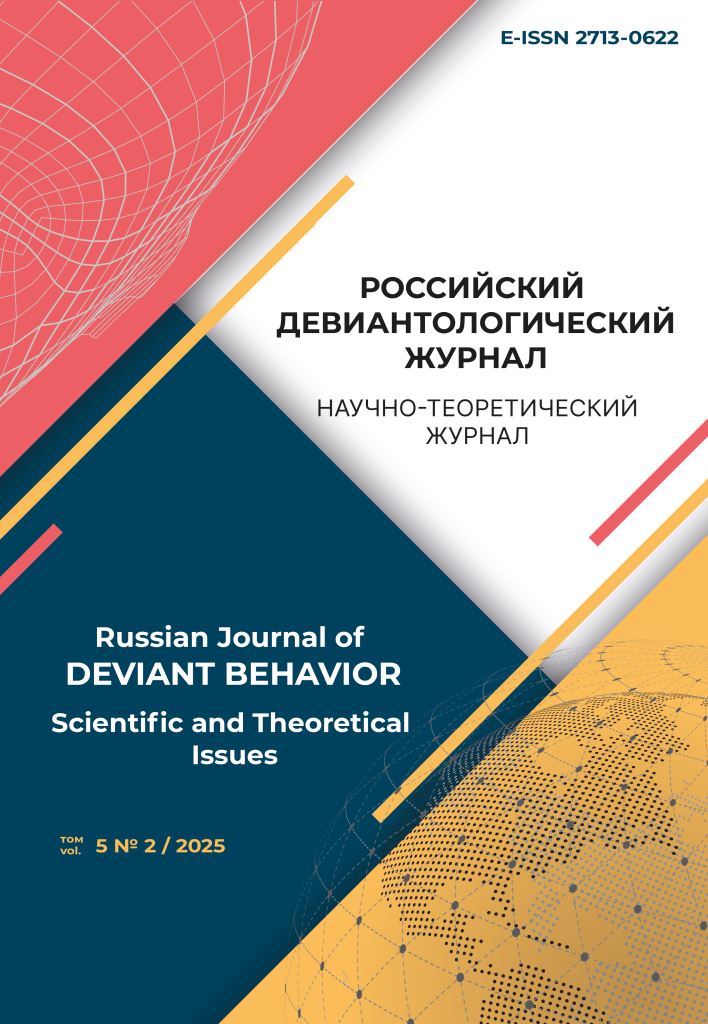St. Petersburg, Russian Federation
UDC 159.9.072.43
UDC 316.6
Introduction. The issue of teenage cyber aggression is getting a special acuteness nowadays. Cyberaggression means any destructive actions committed on the Internet. Researchers actively study the peculiarities of the spread of cyber aggression and the consequences of cyber victimisation. At the same time, the question of the causes of such behaviour remains poorly studied. The lack of a single theoretical construct does not allow to comprehensively study this phenomenon. Thus, the aim of the study was to empirically substantiate the previously proposed theoretical model of socio-psychological determinants of cyber aggression in adolescents. Methods. 325 adolescents, students of 5th-10th grades of general education schools in St. Petersburg took part in the study. The study was conducted using reliable, valid and modern socio-psychological techniques. The tendency to cyberaggression was studied using the questionnaire “Typology of cyberaggression”. Results. Aggressiveness, empathy, styles of behavior in conflict situations, communicative characteristics and social intelligence are presented as the main socio-psychological determinants of cyberaggression. Gender, age and time spent by a teenager on the Internet were marked as conditions affecting cyberaggression. The model was tested using the structural equation method (SEM). During testing, the model proved the influence of all the proposed determinants on cyber aggression in adolescents. The data obtained in the course of the study will serve as a basis for further, more detailed analyses of the phenomenon of cyber aggression in adolescents. They can also be used to create preventive and corrective programmes adapted to different age groups and taking into account the differences in the manifestations of cyber aggressive behaviour in boys and girls.
cyberaggression, adolescents, empirical model, socio-psychological determinants, aggression, empathy, communicative characteristics, conflicts, social intelligence
1. Antipina, S. S. (2021). Oprosnik «Tipologiya kiberagressii»: struktura i pervichnye psihometricheskie harakteristiki. Vestnik Kemerovskogo gosudarstvennogo universiteta, 23 (1(85)), 113–122. https://doi.org/10.21603/2078-8975-2021-23-1-113-122
2. Antipina, S. S. (2022). Social'no-psihologicheskie determinanty kiberagressii: teoreticheskaya mo-del'. Gercenovskie chteniya: psihologicheskie issledovaniya v obrazovanii. Social'naya i ekono-micheskaya psihologiya, (5), 27–35. https://doi.org/10.33910/herzenpsyconf-2022-5-3
3. Len'kov, S. L. (2020). Specifika destruktivnoj kiberagressii v obrazovatel'noj srede. Yaroslavskij pedago-gicheskij vestnik, (4 (115)), 107–117. https://doi.org/10.20323/1813-145X-2020-4-115-107-117
4. Malova, E. O. (2020). Sovremennye realii asocial'nyh proyavlenij podrostkov v internet-prostranstve. Innovacionnoe razvitie professional'nogo obrazovaniya, (2 (26)), 107–114.
5. Soldatova, G. U., Rasskazova, E. I., Chigar'kova, S. V. (2023). Kiberagressiya i cifrovaya kul'tura: predstavleniya podrostkov, molodezhi i roditelej. Moskow: Izdatel'stvo Moskovskogo instituta psihoanaliza.
6. Shejnov, V. P. (2019). Kiberbulling: predposylki i posledstviya. Institut psihologii Rossijskoj akademii nauk, 4 (2(14)), 77–98.
7. Shinkevich, T. V. (2020). Kiberbulling v podrostkovoj srede kak social'no-pedagogicheskaya problema. Ot idei – k innovacii: materialy XXVII Mezhdunarodnoj studencheskoj nauchno-prakticheskoj konferencii v 4 chastyah (g. Mozyr', 23 aprelya 2020 goda, str. 263–264). Mozyr': Mozyrskij gosudarstvennyj pedagogicheskij universitet imeni I. P. Shamyakina.
8. Garaigordobil, M. (2017). Conducta antisocial: conexión con bullying/cyberbullying y estrategias de resolución de conflictos. Psychosocial Intervention, 26, 47–54. https://doi.org/10.1016/j. psi.2015.12.002
9. Hinduja, S., & Patchin, J. W. (2010). Bullying, cyberbullying, and suicide. Archives of Suicide Research, 14 (3), 206–221. https://doi.org/10.1080/13811118.2010.494133
10. Jang, H., Song, J., & Kim, R. (2014). Does the offline bully-victimization influence cyberbullying bhavior among youths? Application of general strain theory. Computers in Human Behavior, 31, 85–93. https://doi.org/10.1016/j.chb.2013.10.007
11. Klomek, A. B., Marrocco, F., Kleinman, M., Schonfeld, I. S., & Gould, M. (2008). Peer victimization, depression, and suicidality in adolescents. Suicide and Life-Threatening Behavior, 38 (2), 166–180. https://doi.org/10.1521/suli.2008.38.2.166
12. Marín-López, I., Zych, I., Ortega-Ruiz, R., Hunter, S. C., & Llorent, V. J. (2019). Relations among online emotional content use, social and emotional competencies and cyberbullying. Children and Youth Services Review, 108, 104647 https://doi.org/10.1016/j.childyouth.2019.104647
13. Patchin, J. W., & Hinduja, S. (2010). Trends in online social networking: adolescent use of My Space over time. New media & society, 12 (2), 197–216. https://doi.org/10.1177/1461444809341857
14. Rodríguez-Hidalgo, A. J., Mero, O., Solera, E., Herrera-López, M., & Calmaestra, J. (2020). Prevalence and psychosocial predictors of cyberaggression and cybervictimization in adolescents: a Spain-Ecuador transcultural study on cyberbullying. PLoS ONE, 15 (11). https://doi.org/10.1371/journal.pone.0241288
15. Sontag, L. M., Clemans, K. H., Graber, J. A., & Lyndon, S. T. (2011). Traditional and cyber aggressors and victims: a comparison of psychosocial characteristics. Journal of Youth & Adolescence, 40, 392–404. https://doi.org/10.1007/s10964-010-9575-9
16. Steffgen, G., König, A., Pfetsch, J., & Melzer, A. (2011). Are cyberbullies less empathic? Adolescents' cyberbullying behavior and empathic responsiveness. Cyberpsychology, Behavior, and Social Networking, 14 (11), 643–648. https://doi.org/10.1089/cyber.2010.0445














